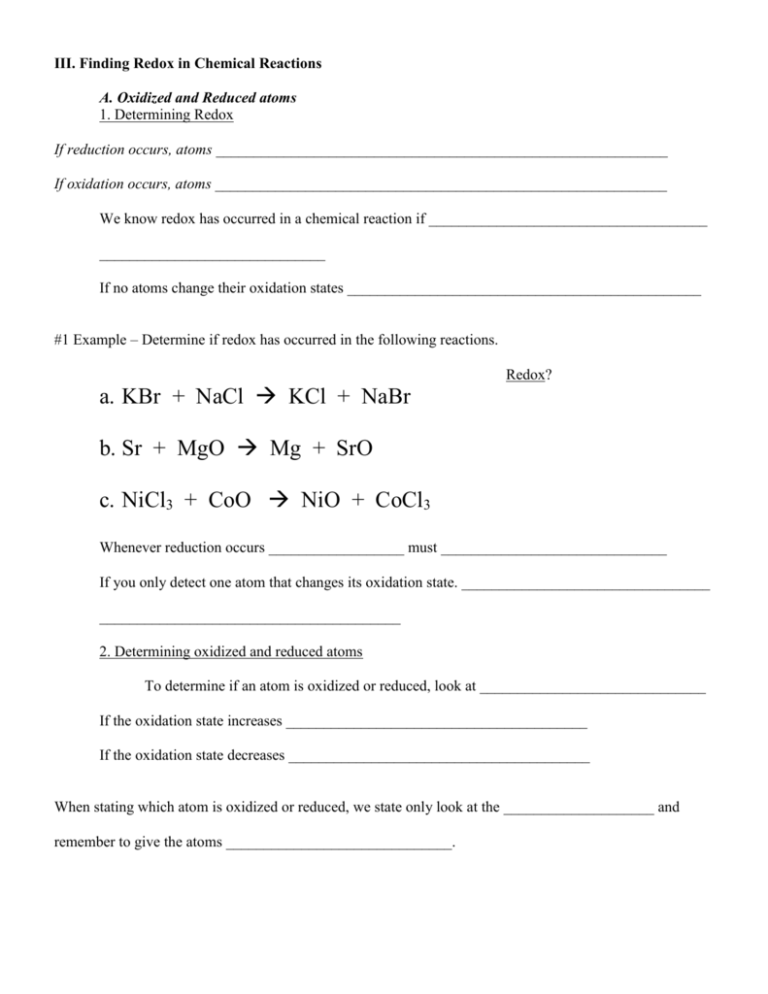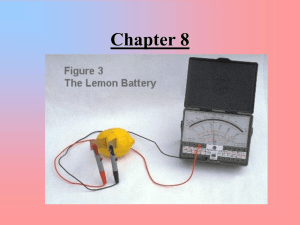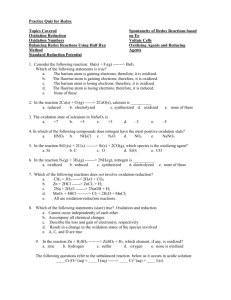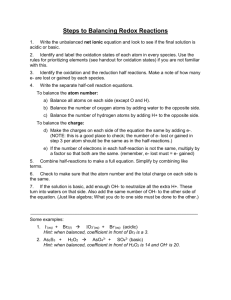B. Oxidizing and Reducing Agents
advertisement

III. Finding Redox in Chemical Reactions A. Oxidized and Reduced atoms 1. Determining Redox If reduction occurs, atoms ____________________________________________________________ If oxidation occurs, atoms ____________________________________________________________ We know redox has occurred in a chemical reaction if _____________________________________ ______________________________ If no atoms change their oxidation states _______________________________________________ #1 Example – Determine if redox has occurred in the following reactions. Redox? a. KBr + NaCl KCl + NaBr b. Sr + MgO Mg + SrO c. NiCl3 + CoO NiO + CoCl3 Whenever reduction occurs __________________ must ______________________________ If you only detect one atom that changes its oxidation state. _________________________________ ________________________________________ 2. Determining oxidized and reduced atoms To determine if an atom is oxidized or reduced, look at ______________________________ If the oxidation state increases ________________________________________ If the oxidation state decreases ________________________________________ When stating which atom is oxidized or reduced, we state only look at the ____________________ and remember to give the atoms ______________________________. #2 Examples – State the oxidized atom and the reduced atom in each of the following reactions Oxidized Reduced a. KBr + Na K + NaBr b. Sr + MgO Mg + SrO c. NiCl3 + CoO NiO + CoCl3 d. FeCl2 + CuCl FeCl3 + Cu B. Oxidizing and Reducing Agents Oxidizing agents are compounds that ____________________________________________ Reducing agents are compounds that _____________________________________________ If an atom is oxidized then its compound is ____________________________________ If an atom is reduced, then its compound is ____________________________________ Remember to look only at ________________________________________________ #3 Examples Determine the oxidizing and reducing agents Ox agent a. NiBr2 + NaBr NiBr3 + Na b. Sr + MgO Mg + SrO c. NiCl3 + CoO NiO + CoCl3 red agent Practice – For the following reactions, assign oxidation numbers, then determine which atoms are oxidized and which are reduced. Then determine the oxidizing and reducing agents. 2 Mg + O2 2 MgO a. b. K + LiOH Li + KOH c. Mg + 2 HCl MgCl2 + H2 d. PbO + MgO PbO2 + Mg Answers to questions #1 a. No b. Yes c. Yes 2. Oxidizd a Na b. Sr c. Co+2 d. Fe+2 Reduced K+ Mg+2 Ni+3 Cu+ 3. Ox agent Red Agent a. NaBr b. MgO c. NiCl3 NiBr2 Sr CoO Did you include the proper charges? Practice Oxidized a. b. c. d. Mg0 K0 Mg0 Pb+2 Reduced O0 Li+ H+ Mg+2 oxidizing agent O2 LiOH HCl MgO Reducing agent Mg K Mg PbO As we have studied, redox refers to the movement of electrons. If an atom loses electrons, it is oxidized, if it gains electrons it is reduced. Now we will look at what happens in a actual chemical reaction. In some reactions, there is no loss or gain of electrons. The atoms may just rearrange themselves, but keep their own electrons. In other reactions, some atoms lose and gain electrons to create a redox reaction. To determine if redox exists, we need to assign oxidation numbers to all atoms on both the products side and the reactants side. If we see a change in oxidation states of an atom, then we can check to see if redox has occurred. For example MgO + CaS MgS + CaO. Assign oxidation numbers to all elements in the reactants and the products. Which elements changed their oxidation states?______________________________ Since the four atoms (Mg, O, Ca and S) all keep the same oxidation states, there is no redox occurring here. Look at this example CaS + Mg MgS + Ca Assign oxidation numbers to all elements in the reactants and products. Which elements changed their oxidation states?______________________________ (Did you remember that a single atom has an oxidation state of zero?) We know that redox has occurred because oxidation states changed. Some atoms lost control of more electrons, others gained control of more electrons. One important factor to remember: Reduction can never occur without oxidation. The two processes must go together in a complete equation. If someone loses electrons, someone else gains electrons. If you ever notice that only one atom changes its oxidation state, then we have a problem. (Either the equation is messed up, or perhaps the oxidation numbers are wrong.) Now that we can recognize if redox has occurred, we need to determine which atoms are oxidized and which are reduced. The easiest way to determine this is to watch what happens to the oxidation states. In the reaction CaS + Mg MgS + Ca, Ca changes its oxidation state from ____________________ to ____________________ Mg changes its oxidation state from ____________________ to ____________________ The only way this can happen is if calcium gains two electrons and magnesium loses two electrons. (Remember, if you lose electrons, you become more positive, and if you gain electrons, you become more negative. ) Some of you are now becoming more negative, Are you gaining electrons? An easy rule to remember is this: If the oxidation state increases, the atom is losing electrons. This is OXIDATION If the oxidation state is decreasing, the atom is gaining electrons. This is REDUCTION. (This is why it is called reduction, the oxidation state is going down.) When indicating which atoms are oxidized or reduced, we name the REACTANT atom with its charge. So for our practice equation CaS + Mg MgS + Ca We would say that the Ca+2 atom is reduced and the Mg atom is oxidized. Remember to pick the reactant, and state its oxidation state. Another example would be: +2 -2 +2 -2 0 +4 -2 CO + MgO Mg + CO2 (check with me if you don’t understand where I got these numbers. ) In this case, we would say that C+2 is oxidized and Mg+2 is reduced. Again, we name the reactant atom with its oxidation state. Now do the notes on finding redox in equations. Determining Oxidizing and Reducing Agents Look at this reaction again. +2 -2 +2 -2 0 +4 -2 CO + MgO Mg + CO2 Now let’s ask ourselves another question. Can we go home now? Now let’s ask ourselves a chemistry question. Why is C+2 oxidized to C+4? The reason is because the Mg+2 in MgO takes the electrons from the C+2. So we can say that the substance or agent that causes the oxidation is the MgO. This is why the MgO is called the oxidizing agent. If we look at it another way, why is the Mg+2 reduced? The reason is because the C+2 in the CO forces its electrons onto the unsuspecting Mg+2 atom. So we can say that the agent which causes reduction is the CO. Thus, the CO is referred to as the reducting agent. If we look at it another way, the atom that is oxidized is part of the reducing agent, and the atom that is reduced is part of the oxidizing agent. Watch how this works. Assign oxidation numbers to all atoms in the reaction ______ ______ ______ ______ ______ ______ _______ FeBr2 + NaBr FeBr3 + Na We know that the Fe+2 atom is oxidized because it becomes Fe+3. Also, the Na+ ion is reduced to Na, so we say that Fe+2 is oxidized Na+ is reduced FeBr2 is the reducing agent NaBr is the oxidizing agent In conclusion, atoms are oxidized and reduced, but whole compounds are oxidizing and reducing agents. Also, remember to get your answers from the reactants side. These are the atoms and compounds that will react. Now do the notes on Oxidizing and Reducing Agents






